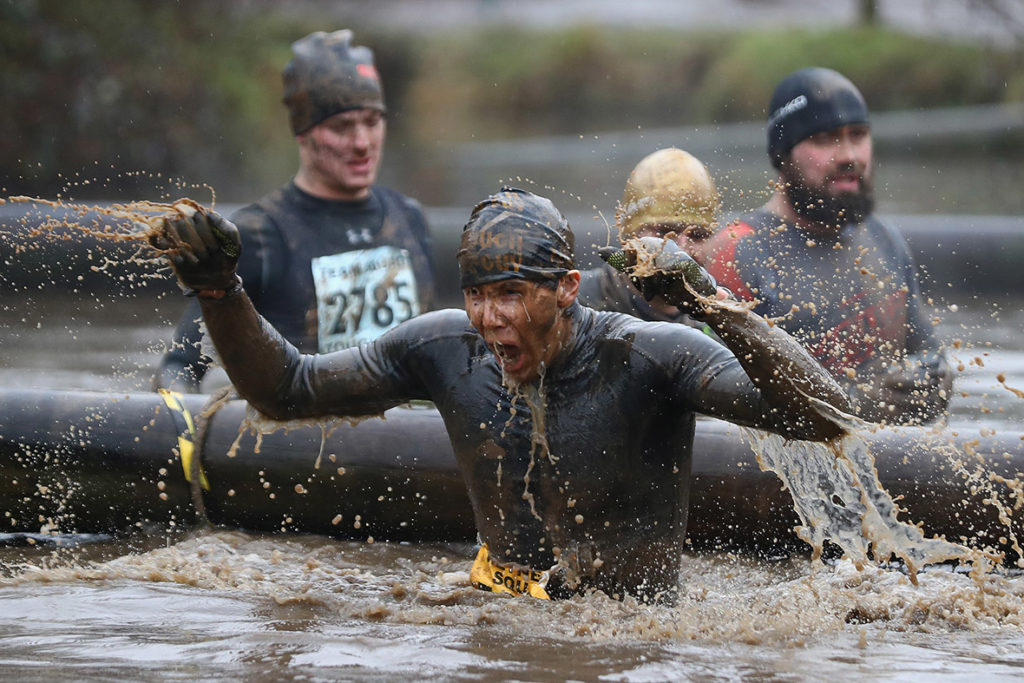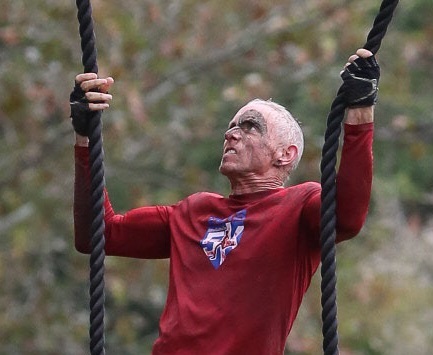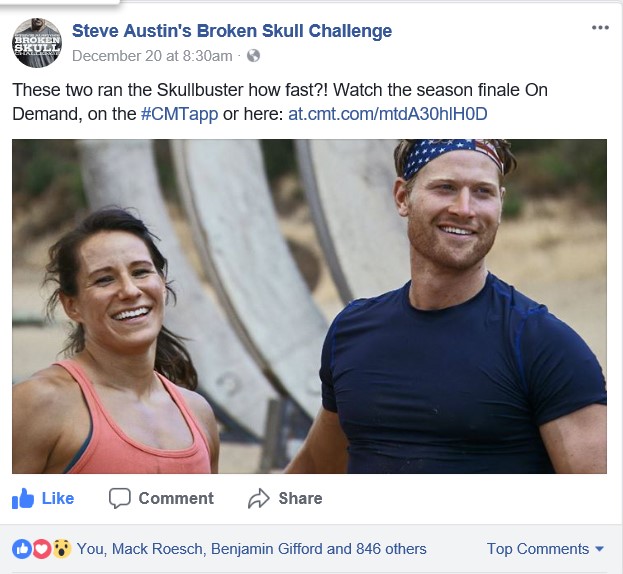Good morning friends. This is your inside guy, the Obstacle Whisperer. I’m here to help you win the Broken Skull Challenge. All season long I brought you episode recaps. Here and there I spiced it up with some tips and tricks. Today you’ll get all that with analysis of each round of competition, each obstacle, and a few more bits you’ll need before you ever get to the set. Or, if your attention span is just too short, here is a tantalizing summary of all you need to know and do:
Master the three basic moves of OCR – air squat, pull-up, and muscle-up. Then do each of them while a partner tries to stop you forcibly. From now on, do all your burpees in water that is over your head. Learn how to wrestle and run in water that comes up to at least your chest. Pick up, carry, and put down heavy, unstable shit repeatedly. And by heavy I mean nothing less than half your bodyweight. Preferably more. When you think you’re done a workout, you’re less than halfway there. That’s it.
Early in the season, I interviewed Brooke Rosalie van Paris. She was in episode 2. Before you submit your application, make your video, or click Send, do this one thing. Craft your story. You better have a story. Brooke’s was easy. Child gymnastics athlete. Life destroyed in a horrific car accident. Hands useless for two years. Came back from it all and started doing competitive bodybuilding and OCR. No matter what show you want to get on (like BSRC, ANW, etc.), you need to have a story. Riches to rags to riches is always a great story.
Now that you are cast, you enter the set and wait for Stone Cold Steve Austin to drive up to meet you. This is your first introduction most likely. But you’ve had some time to hang out with your other cast members. You might become friends. You might keep your distance. But once the camera rolls, the producers, and directors expect the trash talk to start flying, F-bombs dropping, and snarling confrontations to commence. So, no matter your personality, get ready to unload and get unloaded on. Steve typically asks at this point, “Are you ready to back that up on my course?” Well, are ya punk?
This season, the men and ladies started in the Drain. The first thing I’m going to whisper to you is a mantra. “Get comfortable being uncomfortable.” Sound familiar? That’s from The Selection. Are you uncomfortable in water? Get comfortable working out in the water. Find a partner and start wrestling in the water, under the water, with water splashing in your face. Learn how to breathe. Learn how not to drown. From the time to when you first think about entering the show until the moment you jump into the drain, you better train in water. There will always be water obstacles on the Broken Skull Ranch.
Death Grip was the next round. This yoked weight requires two primary skills. Posture first, then power. Learn the posture necessary to successfully lift and carry a boatload of unstable weight. The mechanics of this posture come first. It will save your back and a lifetime of pain. You’ll do this with a hex bar and a lot of powerlifting. If possible, find a way to add weight that is unstable. You want to simulate the obstacle. Go ahead and build one in your backyard. Do whatever it takes. As folks in OCR like to say, get comfortable picking up heavy shit, carrying it, and putting it down. Repeat.
The last challenge of the first week was The Octagon. This time there are three keys. The first is one I learned decades ago from my master. It is the kyup. You see lots of athletes do this, especially powerlifters. The kyup is that yell from the depths of the belly just before they execute the lift. It releases a huge surge of power. You want that surge to get the 800-pound octagon rolling. You also want to be able to do a powerful squat press. Once the beast is rolling, you want to keep it rolling. Lean in and keep up with the upward thrusts of your hands from chest level to above your shoulders. It’s a short range of motion, but that’s where most of the mechanical power is. Fully extended arms below or above have very little mechanical advantage. It all transfers to another body part, costing you time and burning more energy.
Let’s say you make it this far. Now you are in the Pit. How many times this season did I hear someone say they have no experience wrestling? This was my biggest gripe this season. Why no wrestling experience? You watch the show. You know it’s coming. You better get comfortable with lots of brutal human contact in the ring. Start now. Get a coach.
The next week was different. Men started with Rip-Off while the ladies started with Drag Race. Either way, these were wrestling matches. Learn how to wrestle, especially how to use leverage techniques.
Round two was Hoisted for the men and The Wake of the women. This time, two very different challenges. This is where some big surprises came into play. For the men, Victor and Robert came out victorious. Robert is not a big, muscular guy. He is a lean, mean, fighting machine – an Army Ranger. Body weight was not his advantage. Power was his mechanical advantage. Like Robert, you need to learn these techniques. You don’t have to join the military to do that. In fact, Robert, and a few other OCR pros like Hunter and Matt, offer training. I highly recommend it. They’ll show you how to get over big-ass walls fast and furious like the ones in the Wake. They’ll show you how to carry heavy shit for long endurances like those water yokes in the Wake. Robert is an endurance master. Nobody better in the world. Choose your master and learn.
Round three, just before the Pit, was Tire Change for the men and Pile Drive for the women. Tire flipping is an OCR standard. It’s all in the legs. Pile Drive is a sled drag with increasing weight. This is a full-body workout where you lift heavy ass barrels onto a sled then drag the whole thing. You can pull yourself along with a rope or go it alone, harnessed into the sled. Either way, you lean in and drive with those big leg muscles.
The other week of challenges included Trench Warfare (water and wrestling), Stress Test (water, log hurdle, and rope walls), and Boulder Press (carry heavy shit a long way then put it down). By now you get the idea that you will be very uncomfortable. Get comfortable. Get technique down hard. Get in the dirt and water. Repeat. Don’t wait until you get on the show or else you will quickly hear the words, “I’ll see you on down the road.”
Now onto the Skullbuster. The secret to winning the Skullbuster, and by “winning” I mean you get the best time and dethrone the current champion. In this case, that’s Hunter McIntyre with a 6:01 and Corinna Coffin with a 7:12. The secret is all in the first obstacle called Back Breaker. This is a quarter-mile run with a heavy-ass log on your shoulder(s). Let’s break it down.
Hunter runs this portion at about a five-minute per mile race. That means that around 1:15, or 20% of the total Challenge time, is right here. So if you can’t run a five-minute mile on a track with just you and your skivvies, you won’t beat Hunter. Going downhill with an unstable 75-pound log only makes it harder. Learn how to run fast, efficient, and powerful. I recommend two coaches, Richard Diaz of the Natural Running Network and Dennis Wayne Welch of the Endurance Project.
Next is the Wedge. Get comfortable climbing unstable stuff like cargo nets, ropes, and ladders. Grab the ropes on the verticals. There’s less give, and your grip stops at the knots. This gives you a firm pull.
This season, two athletes executed Framed in two different ways that made Steve call out and question what they were doing. Mack grabbed the rope and used his full body weight to pull over the 1200-pound frame as he jumped off the back of the tower. Ana didn’t even wait until the frame crashed down before she let go of the rope, let momentum do its thing, and scampered on to the next obstacle.
She used this technique flawlessly on every obstacle. She simply did not wait to see if she was finished, or if the weight hit the ground, or if Steve gave the go-ahead signal. She knew that momentum would finish the work and she could move on. Precious seconds gained.
She did it again at Turnstile. The kyup is a big one here too. Get that massive 17,000-pound trailer spinning with a yell, then grind away, pushing with the biggest muscles of your body, the glutes, quads, and hamstrings. Let the upper body rest here while the legs do all the work. Also, except for the run on Back Breaker, all the other runs are where you get to rest in between obstacles. This is a new skill that not many athletes use. Hunter is a master. His heart rate drops on the runs and then shoots up as he exerts power on the obstacles.
The secret to Landing Pads is to stand up straight, lock your core, and relax. Bending forward allows gravity to pull you to the ground. On this mandatory re-start element, you don’t want to be on the ground. The best way I found to practice this obstacle is with a pair of two-by-fours turned on side. It’s a ninja trick. Learn to jump from one board to the other, slowly increasing the distance as you improve your ability to balance, jump, lock your core on the landing, and reload.
Rainmaker is 30-feet of water trough through which you carry a sandbell. The water is a system shocker. You’re outside all day in 90 to over a 100-degree heat. By about five minutes into the Skullbuster, your body is at maximum temperature. The water may cramp you. There simply is no training for that. There is only preparation. Get comfortable doing it. Train in the heat and the water. Hydrate. Make sure your electrolytes are balanced during training and while you are on the show.
Athletes showed some different techniques for Burn Out this season. Few managed to leap from the top of one to the other. Most fell short and landed in the water. It looked like a few got hurt when they either missed the grab or their feet twisted in the fall. So, if you want to try this, you’ll practice when you are at maximum heart rate and very tired. Of course, I don’t recommend this. This is a leap from a fairly stable but high log to a very uncertain landing on pillared tires. Your brain is trying to calculate the widest place to stick your feet at the same time as finding the best place for your hands to grip. The problem is, no such places exist. So, get yourself a tire and change your perspective. Make the uncomfortable comfortable. Using that one tire, learn the grips and places on the ground. Kind of like learning Landing Pads using two-by-fours. This is how I teach others to successfully do stump jumps. Start on the ground. Focus your sight only on the landing spots. Never look to the ground. Doing so sends panic signals from your eyes to your brain causing you to tense up, lean forward, and most likely stumble.
Up next is Heartbreak Hill. Everyone eventually gets down on all fours to make the ascent. You will do likewise in your training. If you are like me and live in flat land, you will get a tire and drag it. The heavier the tire, the more you will lean in, simulating a steeper angle. Heartbreak Hill is 40-degrees.
The descents varied across every athlete. Hunter zig-zagged. Corinna started that way, then got down on her butt and slid halfway, then ran the second half. Other’s did jump slides. Nobody ran straight down. That’s near impossible. The question you have to ask yourself here is, do I want to keep my ass unblemished, or do I want a huge race tattoo? Most people choose the latter. It will burn in the shower later on. You will cherish that feeling.
Rib Cage comes next to last. You’ve had very little taxing on your upper body until now. But here it is. You have six dead-lifts in a row. Kyup each one. Use your legs. With that last little bit of thrust with your arms, get the ribs over the tipping point and move on. Don’t wait for them to hit the ground. Move, move, move.
Rope Burn, 25-feet of the climb is all that remains between you and $10,000. Last year in Season 4, so many people failed here because they did not use their feet. It infuriated me to see failure at something so simple. You know you have to climb a rope. So, practice the S-lock or J-lock. Perfect the move. Yes, it slows you down a bit. Yes, the fastest way up is freehand. But you’re cooked by this point, and you need an advantage. Use your feet. Athletes did much better with that in Season 5. Even Hunter, who usually climbs freehand, used his feet.
A question often debated in social media is what type of athlete is most likely to win the Broken Skull Challenge? OCR? CrossFit? Water polo? While OCR has dominated since Season 1, I won’t say that is a rule. In fact, if you have paid attention, you heard me whisper a few secrets. Like in The Selection, you’ll be an unlikely person who can handle extremes of discomfort. Check, check, check for OCR, XF, and water polo. But you’re also a wrestler. Zeroes for all three. You’re also a runner. OCR finally learned that truth by about 2015 in their sport. You’re also a powerlifter. XF the clear winner here. What we are learning is that the best athlete is like a decathlete. They are good at lots of things. Step outside your sport, outside your comfort zone, outside your social circle of friends, and make a few enemies at the bottom of a lake or deep in the dirt of your backyard pit.
My last piece of advice I want to whisper to you is about your ego. It can either haunt you or help you. It can either intrinsically motivate you or extrinsically humiliate you. Hunter is an extrovert, and his ego works very positively for him. His trash talk also has the devastating effect on others because they know he is good. He plants those seeds of self-doubt in others. You need to know just how good you are. Corinna is much more subdued and humble. She just knew deep inside that she is that good. Good enough to beat Cassidy by over 40 seconds.
Disclaimer: The viewpoints expressed by the authors do not necessarily reflect the opinions, viewpoints and official policies of Mud Run Guide LLC, or their staff. The comments posted on this Website are solely the opinions of the posters.






So basically be Ryan Atkins